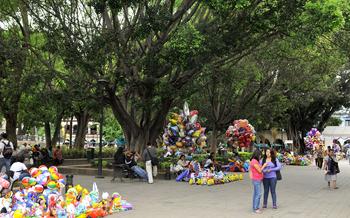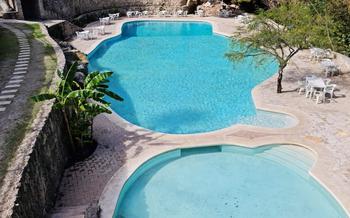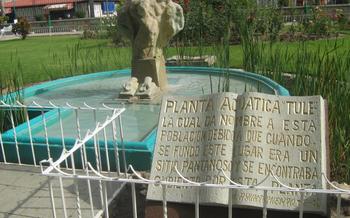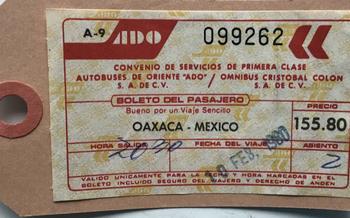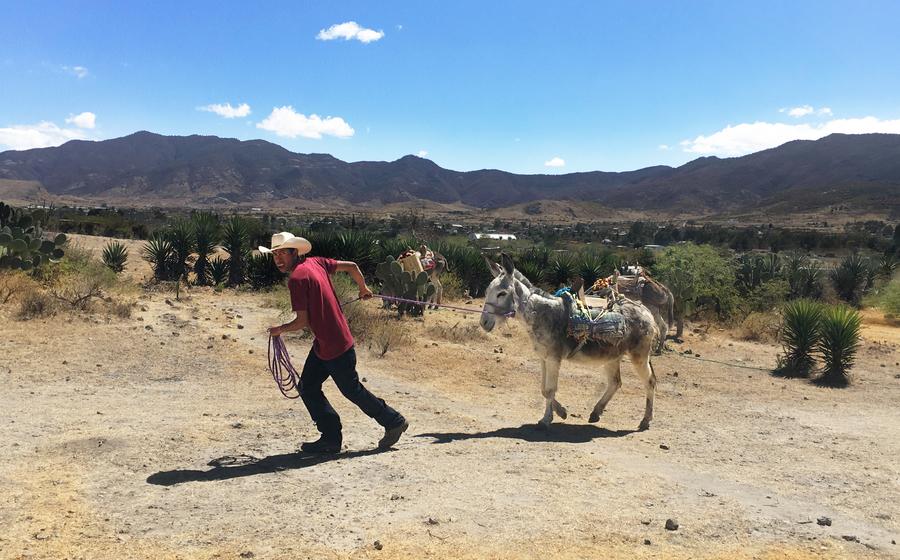
Santiago Matatlán (Mezcal Capital)
- Santiago Matatlán, the Mezcal Capital
- Mezcal Tours and Tastings
- Mezcal Routes and Festivals
- Agave Fields and Plantations
- Local Cuisine and Mezcal Pairings
- Mezcal Museums: Preserving the Legacy
- Cultural Workshops and Experiences
- Mezcal Cocktails and Mixology
- Mezcal Spas and Wellness
- Sustainable Tourism Practices
- Mezcal Art and Crafts
- Mezcal Nightlife
- Mezcal History and Legends
- Mezcal and Social Responsibility
- Insider Tip: Embracing the Essence of Santiago Matatlán
Santiago Matatlán, the Mezcal Capital
Santiago Matatlán, a small town nestled in the heart of Oaxaca, holds a special place in the world of mezcal. Known as the Mezcal Capital, it is widely regarded as the birthplace of this iconic Mexican spirit. The town's history is deeply intertwined with mezcal, with its roots tracing back centuries to pre-Hispanic times. The indigenous Zapotec people, who have inhabited the region for millennia, were among the first to cultivate agave and craft mezcal, using traditional techniques passed down through generations.
Due to its close proximity to Oaxaca City, a mere 45-minute drive away, Santiago Matatlán is easily accessible for travelers seeking an immersive mezcal experience. The town's charming cobblestone streets and colonial architecture provide a glimpse into its rich history and cultural heritage. Its central plaza, adorned with a majestic mezcal plant sculpture, serves as a gathering place for locals and visitors alike, who come together to celebrate the spirit of mezcal.
Mezcal Tours and Tastings
Embark on an unforgettable journey into the world of mezcal by booking a guided tour of the palenques, the heart of mezcal production, in Santiago Matatlán. These tours provide a glimpse into the traditional methods of mezcal making, from harvesting the agave to distilling the spirit. Experience the meticulous care and craftsmanship that goes into each bottle of mezcal as you learn about the different types of agave, the cooking process, and the art of distillation.
During the tour, you'll have the opportunity to sample a range of mezcals, from artisanal brands produced by local families to premium brands that have gained international recognition. Discover the unique flavors and aromas of different agave varieties, each with its own distinct character. Learn to appreciate the complexity and diversity of mezcal as you sip and savor the spirit, guided by knowledgeable experts who will share their insights and passion for mezcal.
Whether you're a seasoned mezcal enthusiast or a newcomer to the spirit, these tours offer an immersive and educational experience that will deepen your understanding and appreciation of mezcal. Take advantage of this opportunity to visit the palenques, meet the mezcaleros, and taste the fruits of their labor in the mezcal capital of the world.
Mezcal Routes and Festivals
Santiago Matatlán and the surrounding region offer a variety of mezcal routes and festivals that showcase the history, culture, and flavors of this agave spirit.
Mezcal Routes:
-
Mezcal Route: This designated route features a collection of mezcal palenques (distilleries), agave fields, and cultural attractions in Santiago Matatlán and nearby villages. Visitors can follow the route to explore the different stages of mezcal production, interact with local mezcaleros, and sample a variety of mezcals.
-
Mezcal Tasting Trail: This trail takes visitors to several mezcal palenques in the region, where they can sample different mezcals and learn about the unique flavors and characteristics of each one. Visitors can also purchase mezcals directly from the producers.
Mezcal Festivals:
-
Mezcal Festival in Santiago Matatlán: Held annually in July, this festival celebrates the mezcal tradition and culture of the region. Visitors can enjoy mezcal tastings, traditional food, live music, dance performances, and cultural exhibitions.
-
Guelaguetza in Oaxaca City: This colorful and vibrant festival takes place in July and August and showcases the diverse cultures and traditions of the Oaxaca region. Visitors can witness traditional dances, parades, and music performances, as well as sample mezcal and other regional delicacies.
Practical Information:
-
Event Dates: The Mezcal Festival in Santiago Matatlán typically takes place in mid-July, while the Guelaguetza in Oaxaca City is held in late July and early August. Check the official websites for specific dates and schedules.
-
Ticket Prices: Admission to the Mezcal Festival in Santiago Matatlán is usually free, while the Guelaguetza in Oaxaca City requires a ticket. Ticket prices vary depending on the type of seating and performance.
-
Transportation: Santiago Matatlán is located about 30 minutes from Oaxaca City by bus or taxi. Buses depart regularly from the main bus station in Oaxaca City. The Guelaguetza festival takes place in the Auditorio Guelaguetza in Oaxaca City, which is easily accessible by public transportation or taxi.
Agave Fields and Plantations
The rolling hills surrounding Santiago Matatlán are a tapestry of verdant agave fields, a testament to the deep connection between this region and the mezcal-making tradition. Visitors can embark on scenic drives or guided tours through these agave plantations, immersing themselves in the breathtaking landscapes and learning about the cultivation process firsthand.
The region is home to a diverse array of agave varieties, each with its own unique characteristics and flavors. Visitors can learn about the different types of agave used for mezcal production, including the ubiquitous espadín, the prized tepeztate, and the rare tobalá.
Sustainable agave farming practices are essential for preserving the region's heritage and ensuring the longevity of the mezcal industry. Visitors can support these practices by choosing mezcals produced by farmers who employ sustainable methods, such as organic farming and water conservation techniques.
Local Cuisine and Mezcal Pairings
Santiago Matatlán and the Oaxaca region are renowned for their diverse and flavorful cuisine, which perfectly complements the unique flavors of mezcal. Traditional dishes such as tlayudas, large, crispy tortillas topped with beans, cheese, and various meats, pair exceptionally well with the smokiness and complexity of mezcal. Mole negro, a rich and flavorful sauce made with over 20 ingredients, including chocolate and chili peppers, is another classic Oaxacan dish that harmonizes beautifully with mezcal.
For a truly immersive culinary experience, try "maridaje", the art of pairing food and drinks to enhance their flavors. Mezcal's smoky and earthy notes pair well with dishes that have a balance of sweet, sour, and salty flavors. Experiment with different mezcals and dishes to find your perfect match.
Here are some tips for creating your own mezcal-inspired culinary experiences:
- Start with a good mezcal: Choose a mezcal that has a flavor profile that complements the dish you are serving.
- Consider the smokiness: The smokiness of mezcal can range from subtle to intense. Pair dishes with a smokiness level that matches the intensity of the mezcal.
- Experiment with different flavors: Mezcal can be paired with a wide variety of flavors, from sweet to sour to spicy. Try different combinations to find what you like best.
- Don't be afraid to ask for help: If you are unsure what to pair with your mezcal, ask a local expert for recommendations.
Mezcal Museums: Preserving the Legacy
In the heart of Santiago Matatlán, history and tradition converge at the Mezcal Museums, inviting visitors to delve into the captivating world of this ancient spirit. These museums showcase a treasure trove of artifacts, tools, and machinery that chronicle the evolution of mezcal production from its pre-Hispanic origins to the present day. Interactive displays, educational programs, and knowledgeable guides bring the intricate process of mezcal-making to life, allowing visitors to witness the craftsmanship and dedication that goes into each bottle.
The museums also highlight the rich cultural heritage of mezcal, showcasing traditional tools, such as the coa for harvesting agave and the tahona stone for crushing the cooked agave. Visitors can learn about the significance of mezcal in local rituals and celebrations, and gain insight into the deep connection between the people of Santiago Matatlán and their mezcal heritage.
These museums serve as a testament to the enduring legacy of mezcal, preserving and promoting the cultural heritage of this iconic spirit for future generations. Whether you're a seasoned mezcal enthusiast or a curious newcomer, a visit to the Mezcal Museums will leave you with a profound appreciation for the history, culture, and craftsmanship that make mezcal so special.
Cultural Workshops and Experiences
Immerse yourself in the art of mezcal making by participating in cultural workshops and experiences offered in Santiago Matatlán. These immersive programs provide a hands-on opportunity to learn about traditional techniques, from harvesting agave to distilling the final product. You'll gain insights into the cultural significance of mezcal and its role in local traditions and rituals. Workshops typically cover topics such as agave cultivation, cooking methods, distillation processes, and mezcal tasting. Whether you're a mezcal aficionado or simply curious about the process, these experiences offer a unique and enriching way to connect with the culture and heritage of this special region.
To find and book these immersive experiences, inquire at local mezcal shops, cultural centers, or through online platforms that promote sustainable tourism in the area. Look for reputable providers that prioritize cultural preservation and responsible practices.
Mezcal Cocktails and Mixology
Mezcal's smoky and complex flavor profile has made it a popular choice for mixologists worldwide. Mezcal-based cocktails offer a unique and flavorful twist on classic recipes, blending the traditional spirit with modern mixology techniques.
Indulge in the classic Margarita, where mezcal replaces tequila, adding a smoky depth to the tangy citrus flavors. The Paloma, a refreshing combination of mezcal, grapefruit soda, and lime, is a must-try for those seeking a light and summery cocktail.
For a taste of innovation, try the Mezcal Negroni, which combines mezcal with gin, Campari, and sweet vermouth, creating a complex and bittersweet symphony of flavors. Mezcal also shines in tiki-style cocktails, where its smokiness complements tropical flavors such as pineapple, coconut, and lime.
When crafting your own mezcal cocktails at home, consider the flavor profile of the mezcal you choose. Smokey mezcals pair well with bold flavors, while sweeter mezcals complement citrus and herbal notes. Experiment with different ingredients and proportions to create your own unique creations.
Mezcal Spas and Wellness
In recent years, Santiago Matatlán and Oaxaca City have emerged as destinations for mezcal-infused spa treatments and wellness experiences. These unique treatments offer visitors a chance to relax, rejuvenate, and immerse themselves in the culture of mezcal.
Some of the most popular mezcal spa treatments include mezcal massages, body wraps, and facials. These treatments often incorporate mezcal-infused oils, lotions, and creams, which are believed to have therapeutic properties. Mezcal is said to be beneficial for relaxation, stress relief, and skin rejuvenation due to its anti-inflammatory and antioxidant properties.
To find reputable spas and wellness centers offering mezcal treatments, visitors can ask for recommendations from their hotel concierge or do some research online. It is essential to choose a spa that uses high-quality products and has experienced therapists.
When booking a mezcal spa treatment, it is essential to let the therapist know if you have any allergies or skin conditions. It is also essential to drink plenty of water before and after the treatment to stay hydrated.
After a mezcal spa treatment, visitors can relax in the spa's lounge or enjoy a mezcal-inspired cocktail or mocktail. They can also purchase mezcal-infused products to continue their wellness journey at home.
Sustainable Tourism Practices
When visiting Santiago Matatlán and the Oaxaca region, it is essential to embrace responsible tourism practices to minimize your environmental impact and support the local community. Choose eco-friendly accommodations that prioritize sustainability, such as hotels or guesthouses that utilize renewable energy sources, conserve water, and promote waste reduction. Opt for local transportation options, such as walking, cycling, or using public transport, to reduce your carbon footprint. Support local businesses, including restaurants, shops, and tour operators, that prioritize sustainability and give back to the community.
Look for opportunities to engage in conservation efforts and projects that aim to preserve the agave landscape and cultural heritage. Participate in reforestation initiatives, volunteer at local organizations working to protect the environment, or support initiatives that promote sustainable agave farming practices. By embracing sustainable tourism, you can contribute to the preservation of Santiago Matatlán's unique heritage while ensuring a positive impact on the environment and local communities.
Mezcal Art and Crafts
The vibrant culture of mezcal in Santiago Matatlán and the Oaxaca region extends beyond the spirit itself, finding expression in a range of unique artwork and handicrafts. Artisans draw inspiration from the agave plant and the mezcal-making process to create beautiful and meaningful pieces that capture the essence of this ancient tradition.
One of the most iconic forms of mezcal-inspired art is the alebrije, a fantastical creature carved from wood and painted in vibrant colors. These whimsical figures often depict animals, mythical beings, or human-animal hybrids, and are believed to bring good luck and protection. Visitors can find alebrijes of all sizes and shapes in the workshops and galleries of Santiago Matatlán and Oaxaca City.
Black pottery is another popular art form in the region. Using a unique technique, artisans create stunning pieces of pottery that are both functional and decorative. The clay is mixed with organic materials, such as sawdust or ground corn, and fired at high temperatures to achieve a distinctive black color. Black pottery is often adorned with intricate designs inspired by nature and the mezcal-making process.
Textile weaving is another important craft in the region. Local artisans use traditional techniques to create beautiful textiles, such as rugs, blankets, and clothing. The designs often incorporate symbols and motifs related to mezcal and the agave plant. Visitors can find a wide variety of handwoven textiles in the markets and shops of Santiago Matatlán and Oaxaca City.
Purchasing mezcal-inspired art and crafts is a wonderful way to support local artisans and take home a unique souvenir of your visit to Santiago Matatlán. When shopping, be sure to ask about the artist and the inspiration behind their work. This will help you appreciate the craftsmanship and cultural significance of each piece.
Mezcal Nightlife
Santiago Matatlán and Oaxaca City come alive at night with a vibrant mezcal scene. Mezcal bars and nightclubs offer a range of experiences, from intimate tasting rooms to lively dance floors.
For a truly immersive experience, head to La Mezcaloteca, a mezcal bar in Santiago Matatlán that features over 200 different mezcals from across the region. Enjoy a flight of mezcals, paired with traditional Oaxacan snacks, while listening to live music or watching a cultural performance.
In Oaxaca City, Mezcalería In Situ is a popular spot for mezcal enthusiasts. With its stylish ambiance and extensive mezcal menu, it's the perfect place to sample some of the finest mezcals Oaxaca has to offer.
For a more lively atmosphere, head to Mezcalogia, a mezcal bar with a dance floor and live music. Dance the night away to the infectious rhythms of traditional Oaxacan music, while sipping on mezcal cocktails and enjoying the company of locals and fellow travelers.
No matter your preference, Santiago Matatlán and Oaxaca City have something to offer everyone when it comes to mezcal nightlife. Embrace the vibrant atmosphere, indulge in delicious mezcal cocktails, and immerse yourself in the local culture.
Mezcal History and Legends
Mezcal holds a deep historical significance in Mexican culture, dating back to pre-Hispanic times. Its roots can be traced to ancient civilizations such as the Mayans and Aztecs, who revered mezcal for its medicinal properties and spiritual significance. According to legend, mezcal was discovered by Mayahuel, the Aztec goddess of fertility and nourishment, who shared its secrets with humans as a gift from the gods.
Over the centuries, mezcal became an integral part of Mexican culture, playing a crucial role in religious ceremonies, celebrations, and daily life. It was believed to possess healing powers and was used to treat various ailments, including digestive issues, wounds, and snake bites. Mezcal was also a symbol of hospitality and was often offered to guests as a sign of respect and friendship.
During the colonial era, the Spanish introduced distillation techniques to Mexico, which led to the development of modern-day mezcal. The production of mezcal flourished in the state of Oaxaca, where the ideal climate and soil conditions favored the growth of agave plants. Today, mezcal is recognized as a national treasure and is celebrated for its rich history, cultural significance, and unique flavors.
Mezcal and Social Responsibility
The production and consumption of mezcal have a significant social and economic impact on the region of Oaxaca. To ensure the sustainability of this industry and improve the livelihoods of mezcaleros, several organizations and initiatives are working to promote fair trade practices and responsible mezcal production.
One such organization is the Mezcal Regulatory Council (CRM), which establishes standards for mezcal production and certifies mezcals that meet these standards. By supporting mezcals that have been certified by the CRM, consumers can contribute to the economic development of the region and ensure that mezcaleros are receiving fair compensation for their products.
Other initiatives, such as the Sustainable Mezcal Program, focus on promoting sustainable farming practices and reducing the environmental impact of mezcal production. By supporting mezcal brands that are committed to sustainability, consumers can help preserve the agave landscape and protect the cultural heritage of mezcal.
By choosing to purchase mezcals from responsible brands and supporting organizations that promote fair trade and sustainability, travelers can contribute to the positive development of the mezcal industry and ensure that the benefits of mezcal production are shared by all.
Insider Tip: Embracing the Essence of Santiago Matatlán
Discover the Hidden Gem: Palenque La Curandera
In the heart of Santiago Matatlán, nestled amidst the agave fields, lies a hidden gem that embodies the true spirit of mezcal craftsmanship: Palenque La Curandera. This family-run distillery has been producing artisanal mezcal for generations, using traditional methods passed down from their ancestors. Visitors to La Curandera are treated to an intimate and immersive experience, witnessing the entire mezcal-making process from harvesting the agave to distilling the spirit. The palenque's rustic charm and passionate owners create a welcoming atmosphere where visitors can learn about the history and culture of mezcal while savoring the exquisite flavors of their handcrafted spirits.
Tips for an Unforgettable Visit
To fully embrace the essence of Santiago Matatlán and its mezcal culture, consider visiting during the annual Mezcal Festival, held each July. This vibrant celebration showcases the region's finest mezcals, accompanied by traditional music, dance, and food. For a truly authentic experience, venture beyond the main festival grounds and explore the smaller palenques, where you'll find hidden gems and the opportunity to interact with local mezcaleros.
Respecting Local Customs and Traditions
When interacting with the locals in Santiago Matatlán, remember to be respectful of their customs and traditions. Always ask permission before taking photos, and be mindful of your behavior in public spaces. Strike up conversations with the locals to learn about their way of life and the importance of mezcal in their culture. Your genuine interest and curiosity will be met with warmth and hospitality.
Secret Spots for Mezcal Enthusiasts
For those seeking a deeper dive into the world of mezcal, explore the secret spots frequented by locals and mezcal aficionados. Visit the Mezcaloteca Museum in Oaxaca City to learn about the history and production of mezcal through interactive exhibits and tastings. Indulge in mezcal-inspired cuisine at La Casa del Mezcal restaurant, where you can savor dishes that perfectly pair with the smoky flavors of mezcal. Uncover hidden mezcal bars and shops tucked away in the charming streets of Santiago Matatlán and Oaxaca City, where you can sample rare and unique mezcals that are not easily found elsewhere.
By embracing these insider tips, you'll unlock the true essence of Santiago Matatlán and experience the magic of mezcal beyond the tourist trail. Immerse yourself in the local culture, connect with the passionate people who make this spirit come alive, and create memories that will last a lifetime.


